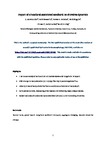Impact of a headland-associated sandbank on shoreline dynamics
| dc.contributor.author | McCarroll, Jak | |
| dc.contributor.author | Masselink, Gerd | |
| dc.contributor.author | Valiente, NG | |
| dc.contributor.author | Wiggins, Mark | |
| dc.contributor.author | Scott, Tim | |
| dc.contributor.author | Conley, Daniel | |
| dc.contributor.author | King, EV | |
| dc.date.accessioned | 2020-03-16T09:14:06Z | |
| dc.date.available | 2020-03-16T09:14:06Z | |
| dc.date.issued | 2020-04-15 | |
| dc.identifier.issn | 0169-555X | |
| dc.identifier.issn | 1872-695X | |
| dc.identifier.other | 107065 | |
| dc.identifier.uri | http://hdl.handle.net/10026.1/15454 | |
| dc.description.abstract |
Sandbanks can occur downdrift of headlands across embayments as a result of tidal currents and wave forcing, and may present a potentially valuable resource of marine aggregate material. Large sandbanks can alter tidal flows and, through refraction and dissipation, increase or decrease wave exposure along the shoreline of an embayment. The impact of offshore sandbanks on shoreline morphodynamics at varying timescales has not been rigorously investigated. Here we show, for the first time, that removing, lowering or raising a headland-associated sandbank can have a significant impact on longshore sediment transport. A Delft3D model of Start Bay and Skerries Bank, UK, validated on hydrodynamic observations, was used to conduct the numerical experiments. Results indicate that removing or lowering the bank generally reduces dissipation and increases wave heights, increasing longshore flux in the lee of the bank. Raising the bank generally has the opposite effect, increasing dissipation and lowering flux. Under oblique waves, the bank may protect the adjacent shoreline by refracting waves away from the coast. Shoreline flux for the region directly onshore of the bank acts as a continuous function of bank height (R2 = 0.7), but correlations for distal regions are increasingly non-linear or absent. A raised bank would reduce transport rates to near-zero across extensive sections of the bay, reversing the long-term net flux at points distal (>5 km from bank) from the bank location, causing currently eroding regions to accrete. Our results demonstrate that moderate (≤5 m) elevation changes to a sandbank will likely produce significant variations in wave power at the shoreline, which will: (i) modify the shoreline response for individual storms; and (ii) substantially change shoreline morphology at decadal timescales. From a broader perspective, this study can be used to inform planning decisions involving naturally varying banks and/or potential mining of sandbanks, aiding shoreline protection strategies for locations with similar embayment-sandbank configurations. | |
| dc.format.extent | 107065-107065 | |
| dc.language | en | |
| dc.language.iso | en | |
| dc.publisher | Elsevier BV | |
| dc.subject | Banner bank | |
| dc.subject | Gravel beach | |
| dc.subject | Longshore sediment transport | |
| dc.subject | Aggregate dredging | |
| dc.subject | Decadal shoreline change | |
| dc.title | Impact of a headland-associated sandbank on shoreline dynamics | |
| dc.type | journal-article | |
| dc.type | Journal Article | |
| plymouth.author-url | https://www.webofscience.com/api/gateway?GWVersion=2&SrcApp=PARTNER_APP&SrcAuth=LinksAMR&KeyUT=WOS:000527300500004&DestLinkType=FullRecord&DestApp=ALL_WOS&UsrCustomerID=11bb513d99f797142bcfeffcc58ea008 | |
| plymouth.volume | 355 | |
| plymouth.publication-status | Published | |
| plymouth.journal | Geomorphology | |
| dc.identifier.doi | 10.1016/j.geomorph.2020.107065 | |
| plymouth.organisational-group | /Plymouth | |
| plymouth.organisational-group | /Plymouth/Faculty of Science and Engineering | |
| plymouth.organisational-group | /Plymouth/Faculty of Science and Engineering/School of Biological and Marine Sciences | |
| plymouth.organisational-group | /Plymouth/PRIMaRE Publications | |
| plymouth.organisational-group | /Plymouth/REF 2021 Researchers by UoA | |
| plymouth.organisational-group | /Plymouth/REF 2021 Researchers by UoA/UoA07 Earth Systems and Environmental Sciences | |
| plymouth.organisational-group | /Plymouth/Research Groups | |
| plymouth.organisational-group | /Plymouth/Research Groups/Marine Institute | |
| plymouth.organisational-group | /Plymouth/Users by role | |
| plymouth.organisational-group | /Plymouth/Users by role/Academics | |
| plymouth.organisational-group | /Plymouth/Users by role/Researchers in ResearchFish submission | |
| dcterms.dateAccepted | 2020-02-01 | |
| dc.rights.embargodate | 2021-1-31 | |
| dc.identifier.eissn | 1872-695X | |
| dc.rights.embargoperiod | Not known | |
| rioxxterms.versionofrecord | 10.1016/j.geomorph.2020.107065 | |
| rioxxterms.licenseref.uri | http://www.rioxx.net/licenses/all-rights-reserved | |
| rioxxterms.licenseref.startdate | 2020-04-15 | |
| rioxxterms.type | Journal Article/Review | |
| plymouth.funder | Physical and biological dynamic coastal processes and their role in coastal recovery (BLUE-coast)::NERC | |
| plymouth.funder | Physical and biological dynamic coastal processes and their role in coastal recovery (BLUE-coast)::NERC |


